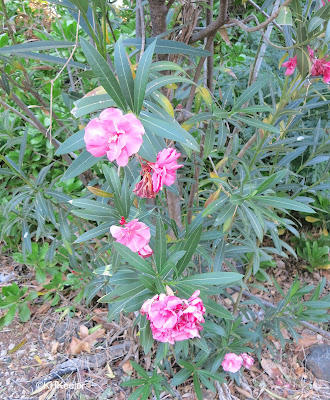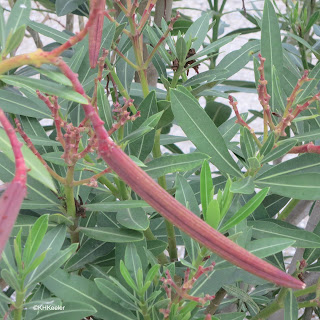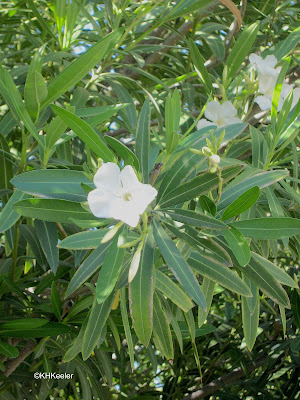Oleander, Nerium oleander (dogbane family, Apocynaceae) has for years been, for me, an example of how comfortably we live with poisonous plants. Oleander is very poisonous. Adults are hospitalized after eating several leaves, die from a serving of leaves. The plants contain a series of very toxic alkaloids, oleandrin, oleandrigenin, oleandroside, neroside, and more. All parts of the plant, including the flower petals, sap, honey, twigs, and roots, contain these alkaloids. They are not destroyed by drying or heat, and the smoke from an oleander fire can be dangerous. However, the story that a boy scout troop died of cooking hot dogs on oleander sticks is an urban legend (see Snopes).
 |
| oleander, Nerium oleander |
Maybe. But knowing to avoid a poisonous plant requires both knowing it is poisonous and recognizing it. I suspect that lots of people can do one but not both of those. My own take is that we generally walk passively by all plants and neither touch nor taste them. If you don't contact oleander, especially if you don't chew on it, it won't bother you. Further discouraging poisoning, oleander is very bitter, so unpleasant to eat.
 |
| double-petaled oleander |
Oleander is native to southern Europe and the Near East. In the very large plant family Apocynaceae with 4,500 species, the genus Nerium has only one species, N. oleander. It shares its common name with several related plants, in particular yellow oleander, Cascabela thevetia, which has similar nasty alkaloids. The name Nerium was the classical Greek name for the plant and oleander was one of its names in ancient Rome, apparently a reference to its olive-green linear leaves looking like olive leaves.
Common names in English include rose-bay and rose laurel.
 |
| oleander seed pod |
Oleander has been grown as an ornamental around the Mediterranean, including Egypt, Greece, and Rome, north Africa and the Holy Land since ancient times. Its names in those areas and languages are similar to the names for bay laurel (Laurus nobilis), cherry laurel (Prunus laurocerasus) and daphne (Daphne species), making identification in ancient writings more tantalizing than definitive.
It has been and is still used in folk medicine, despite its toxicity. People continue to be poisoned by it, not often, about one or two a year, worldwide. Most of those in the 21st century seem to have taken an extract of oleander as a medicine. Medical authorities assert it is too poisonous to consume in any form. The topical applications, for example for skin problems, may have some value, but there are probably safer treatments.
Furthermore, some people react to even touching oleander with a rash.
 |
| oleander, Nerium oleander |
It doesn't appear in English folklore because the plant is only marginally hardy in England, but Cunningham reported that Italians considered "keeping any part of oleander in the house to bring sickness, disgrace and misfortune" (p.164). The toxicity of the plant attracts attention and so it appears in mystical contexts representing love, or danger, or even peace (link), or as "beware" in the Victorian language of flowers.
 |
| oleander along a path |
Do we like living dangerously amid poisonous plants or just not care that it is poisonous? Whatever your conclusion about human association with oleander, it is a handsome garden plant; very hardy, with beautiful fragrant flowers, in reds, pinks, yellows, white, and intermediate shades.
 |
| oleander with white flowers |
References
Baldwin, R. E. 1979. Hawaii's Poisonous Plants. The Petroglyph Press, Ltd., Hilo, Hawaii.
Cunningham, S. 1993. Cunningham's Encyclopedia of Magical Herbs. Llewellyn Publications. St. Paul, Minnesota.
Greenaway, K.1978. Kate Greenaway's Language of Flowers. Avenel Books. New York.
Hyam, R. and R. Pankhurst. 1995. Plants and their Names. Oxford University Press. London.
McDonald, E. 2002. The 400 Best Garden Plants. Quantum Publishing. London.
Missouri Botanical Garden. 2022. Nerium oleander. Missouri Plant Finder link Accessed 11/26/22.
see also Wikipedia. Nerium oleander.
Wonderful blog...keep blogging
ReplyDeleteBlack Pepper Online Shopping | Buy Black Pepper